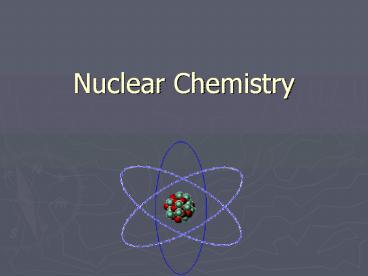Nuclear%20Chemistry - PowerPoint PPT Presentation
Title:
Nuclear%20Chemistry
Description:
Nuclear Chemistry Isotopes-Review Isotopes are atoms of the same element that have the same # of protons but ... This is the type of reaction used in nuclear bombs. – PowerPoint PPT presentation
Number of Views:592
Avg rating:3.0/5.0
Title: Nuclear%20Chemistry
1
Nuclear Chemistry
2
Isotopes-Review
- Isotopes are atoms of the same element that have
the same of protons but different of neutrons
or mass. - X
Atomic mass
Atomic number
3
- When the size and mass of the nucleus becomes
large (greater than atomic 83), the element is
known to be radioactive (unstable) because it
decays. - Examples
- Pu-239 (94 protons), U-238 (92 protons)
- When the ratio of neutrons to protons is greater
than 11 (for light nuclei) , the element is also
radioactive. - Examples
- Carbon-14, Lithium-7
4
Natural radioactivity
- Occurs when nuclei are unstable.
- For any element, an isotope that is unstable is
called a radioisotope.
5
Particles Emitted
- When a nucleus decays, it emits particles.
6
Alpha Decay
- when an unstable nucleus emits an alpha
particle, this is called alpha decay.
7
Beta Decay
- When an unstable nucleus emits a beta particle,
this is called a beta decay.
8
Positron Emission
- When an unstable nucleus emits a positron, it is
called positron emission
9
Writing Nuclear Equations
- Obeys laws of conservation of mass and charge.
10
Natural Transmutation
- Begins with one nucleus that spontaneously
decays. - Always has ONE REACTANT.
11
Artificial Transmutation
- Bombardment of the nucleus with high energy
particles. - Always has TWO REACTANTS.
12
Fission Reactions
- Involve the splitting of a heavy nucleus to
produce lighter nuclei.
Fission reactions produce/capture neutrons. They
can become involved in another fission reaction.
13
- If the number of neutrons released is not
controlled a chain reaction will occur. - This is the type of reaction used in nuclear
bombs.
14
Fusion Reactions
- Involves the combining of nuclei to produce
heavier ones.
15
- In fission and fusion reactions, there appears to
be a loss of mass. However, this mass has been
converted to energy by the equation - E mc2
16
Nuclear vs. Chemical Fission vs. Fusion
- The energy of nuclear reactions is much greater
than the energy associated with chemical
reactions. - The energy of fission is greater than the energy
of fusion.
17
Half-Life
- Radioactive substances decay at a rate that is
not dependent on temperature, pressure, or
concentration. - Half-life is the time it takes for half the atoms
in a given sample of an element to decay. - See Table N for half-lives and modes.
18
Uses of Radioactivity
- Dating? C-14 used to date organic remains
U-238Pb-206 for minerals
19
Uses continued
- Chemical tracers? can follow the path of a
material (ex fertilizer) - Industrial applications? can test thickness or
strength of materials
20
Uses continued
- Medical applications? must have short half-life
and quickly eliminated from body, I-131 thyroid,
Tc-99/Co-60 cancer
21
Dangers of Radioactivity
- Damage to tissue
- Gene mutation































